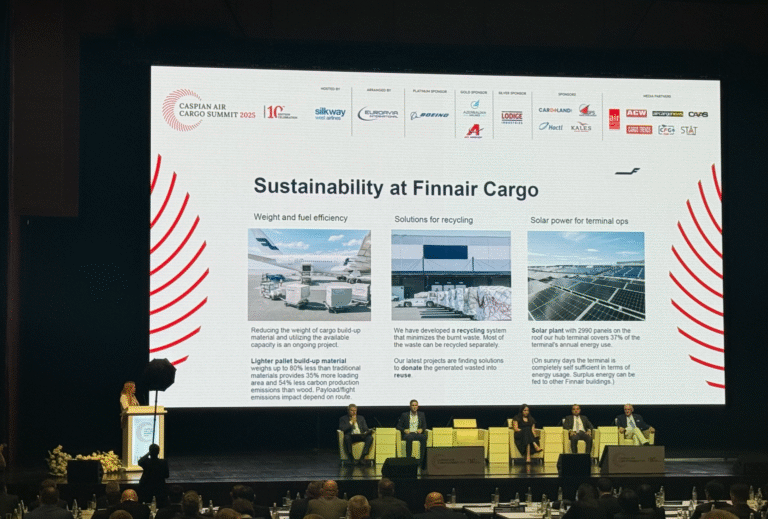At the Caspian Air Cargo Summit 2025, Anna-Maria Kirchner, Head of Global Sales at Finnair Cargo, outlined how the Nordic carrier is tackling the sustainability challenge, with a sharp focus on sustainable aviation fuel (SAF) as the most impactful tool available to the sector today.
Net-zero depends on SAF
Kirchner pointed out that aviation’s path to net-zero by 2050 is inseparable from SAF adoption. “If we continue with our net zero goals for 2050, IATA has calculated that we will need 65 percent of SAF to be fuelled on the aircraft,” she said .
Despite this, progress remains limited. In 2024, just 1.3 million litres of SAF were purchased by airlines in the EU – amounting to a mere 0.3 percent of global consumption . With the EU now mandating a 2% SAF blend, Kirchner stressed that scaling production and uptake is critical to ensuring that airlines can meet their climate commitments.
Finnair estimates that 75 percent of its net-zero pathway will rely on SAF and emerging alternatives such as electrofuels, with the balance coming from new technologies like electric and hydrogen flight once they become commercially viable .
Pioneering new fuels with Liquid Sun
In August 2025, Finnair took a step beyond conventional SAF with a partnership on Liquid Sun, an electrofuel project that uses solar power to split water into hydrogen, which is then converted into renewable fuel.
“Part of the Finnair strategy is preparing for an energy transformation. We have partnered with ABB, Fortum, and Finavia to produce eSAF, which gives us a huge advantage as an alternative or an extra to SAF,” Kirchner explained .
Although still at an early stage, she highlighted that every incremental step matters. “This has just started now in August. It will be little what we get out of it, but we always say every step counts in the journey of sustainability,” she said .
Beyond fuel: operational innovation
While SAF dominates the long-term decarbonisation debate, Kirchner also drew attention to practical measures Finnair Cargo has already implemented in its operations.
Trials are underway using lightweight cardboard pallets, developed by Finnish company Eltete, which are 50–100kg lighter than traditional wooden pallets. These provide lower emissions, reduced costs, and reusability on long-haul flights such as those to Seoul .
In line with Finland’s circular economy principles, Finnair has also developed a recycling programme for uniforms, turning old garments into new textiles. In cargo operations, even waste streams are being redirected: unsellable fish from its Helsinki cool hub are now donated to the Helsinki Zoo as animal feed .
Terminals powered by the sun
Another notable step is the installation of 2,990 solar panels at Finnair Cargo’s state-of-the-art hub in Helsinki, opened in 2018. These panels generate 37 percent of the facility’s annual electricity needs, with surplus power fed into catering operations and airport offices during the long days of Finland’s summer .
Kirchner said that while these efforts may seem modest compared to the scale of aviation’s climate challenge, they demonstrate how incremental action adds up. “Rome wasn’t built in a day – and neither will aviation sustainability,” she remarked .
Education and collaboration
Kirchner stressed that collaboration across the aviation value chain is vital, particularly when it comes to standardising emissions reporting and SAF claims. Finnair has partnered with Neste, also headquartered in Finland and one of the world’s leading SAF producers, to create education programmes for forwarders and shippers.
“We hear a lot about reporting. How are the emissions being calculated? What is a booking claim process? How can shippers, how can forwarders, how can we do this together? The most important journey for us is our future, but also how we collaborate with partners in the industry,” she said .
For Kirchner, the most important message is credibility: the industry must “walk the talk.” By investing in SAF, testing new fuels, and embedding circular economy thinking into daily cargo operations, Finnair Cargo is positioning itself as a frontrunner in aviation sustainability.
“Most important is to think about what else we can do to make sure that the planet we’re living in will also be something with a 2050 net-zero target achieved,” she concluded .





